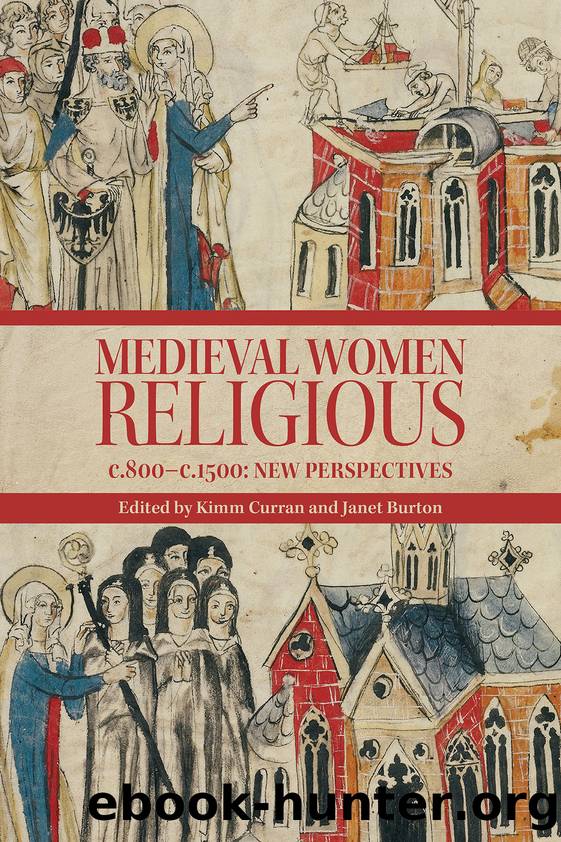Medieval Women Religious, C. 800-c. 1500 by Kimm Curran;Janet Burton;

Author:Kimm Curran;Janet Burton;
Language: eng
Format: epub, pdf
Publisher: Boydell & Brewer
Published: 2023-01-24T00:00:00+00:00
Conclusion
In conclusion, the scholarship of the last twenty or so years has clearly established that the women who directed religious communities had extensive authority and agency. What awaits further investigation is a sense of how that power waxed and waned over time. Jennifer Edwardsâs work on the superiors of Sainte-Croix is an excellent example of a longitudinal study, but we need more of these to understand better the forces that shaped the exercise of this kind of authority by women religious.78 Another priority is to explore fully the gendered dimensions of this exercise of power. To what extent did their status as women shape the contours of how the heads of female houses wielded their authority and influence? Here, comparative studies that included the roles and responsibilities of heads of male houses could be instructive.
The perspective presented in this chapter is a relative snapshot of the authority and agency of medieval heads of womenâs religious communities and prompts important conclusions and highlights areas for further research. First, the office provided meaningful opportunities for women to assume leadership roles. From directing the liturgical obligations of their communities to managing complex patrimonies, these women were entrusted with â and mostly successfully executed â significant responsibilities. Many of these challenged existing gender norms. That mother superiors heard confessions, left the cloister, and supervised male clerics, should force a reconsideration of the extent to which these norms were observed and enforced. Second, they performed these tasks and managed these communities with the assistance of a diverse range of individuals. Other conventual officers, bishops, secular lawyers, bailiffs, and stewards, all had a hand in supporting and aiding the head of the community in her work. Therefore, her responsibilities allowed her to create strong networks and communities. Finally, all this evidence should encourage a further consideration of the convent as a site of significant power and influence for medieval women. The womenâs monastic household provided striking opportunities for women both individually and collectively to exercise influence and assert their agency in ways that were not readily available to most women in secular society.
Download
Medieval Women Religious, C. 800-c. 1500 by Kimm Curran;Janet Burton;.pdf
This site does not store any files on its server. We only index and link to content provided by other sites. Please contact the content providers to delete copyright contents if any and email us, we'll remove relevant links or contents immediately.
| Africa | Americas |
| Arctic & Antarctica | Asia |
| Australia & Oceania | Europe |
| Middle East | Russia |
| United States | World |
| Ancient Civilizations | Military |
| Historical Study & Educational Resources |
Cecilia; Or, Memoirs of an Heiress — Volume 1 by Fanny Burney(32064)
Cecilia; Or, Memoirs of an Heiress — Volume 3 by Fanny Burney(31459)
Cecilia; Or, Memoirs of an Heiress — Volume 2 by Fanny Burney(31409)
The Secret History by Donna Tartt(18168)
Sapiens: A Brief History of Humankind by Yuval Noah Harari(13993)
Leonardo da Vinci by Walter Isaacson(12807)
The Radium Girls by Kate Moore(11624)
Sapiens by Yuval Noah Harari(5125)
How Democracies Die by Steven Levitsky & Daniel Ziblatt(4965)
The Wind in My Hair by Masih Alinejad(4847)
Homo Deus: A Brief History of Tomorrow by Yuval Noah Harari(4691)
Endurance: Shackleton's Incredible Voyage by Alfred Lansing(4508)
Man's Search for Meaning by Viktor Frankl(4292)
The Silk Roads by Peter Frankopan(4275)
Millionaire: The Philanderer, Gambler, and Duelist Who Invented Modern Finance by Janet Gleeson(4105)
The Rape of Nanking by Iris Chang(4024)
Hitler in Los Angeles by Steven J. Ross(3800)
The Motorcycle Diaries by Ernesto Che Guevara(3788)
Joan of Arc by Mary Gordon(3786)
